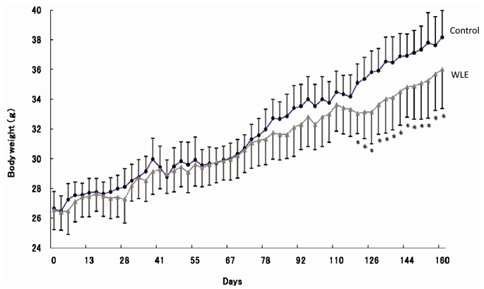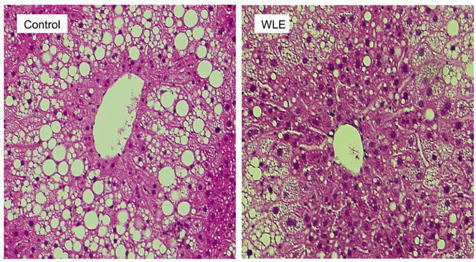Nutr Res Pract.
2013 Aug;7(4):267-272.
Anti-obesity effects of hot water extract from Wasabi (Wasabia japonica Matsum.) leaves in mice fed high-fat diets
- Affiliations
-
- 1Department of Environmental and Preventive Medicine, Shimane University School of Medicine, 89-1 Enya-cho, Izumo City, Shimane 693-8501, Japan. myamasak@med.shimane-u.ac.jp
- 2Shimane Institute for Industrial Technology, 1 Hokuryo-cho, Matsue City, Shimane 690-0816, Japan.
Abstract
- The anti-obesity effects of a hot water extract from wasabi (Wasabia japonica Matsum.) leaves (WLE), without its specific pungent constituents, such as allyl-isothiocyanate, were investigated in high fat-diet induced mice. C57J/BL mice were fed a high-fat diet (control group) or a high-fat diet supplemented with 5% WLE (WLE group). Physical parameters and blood profiles were determined. Gene expression associated with lipid metabolism in liver and white adipose tissue were analyzed. After 120 days of feeding, significantly lower body weight gain, liver weight and epididymal white adipose tissue weight was observed in the WLE group compared to the control group. In liver gene expression within the WLE group, PPARalpha was significantly enhanced and SREBP-1c was significantly suppressed. Subsequent downstream genes controlled by these regulators were significantly suppressed. In epididymal white adipose tissue of the WLE group, expression of leptin, PPARgamma, and C/EBPalpha were significantly suppressed and adiponectin was significantly enhanced. Acox, related to fatty acid oxidization in adipocytes, was also enhanced. Our results demonstrate that the WLE dietary supplement induces mild suppression of obesity in a high-fat diet induced mice, possibly due to suppression of lipid accumulation in liver and white adipose tissue.
Keyword
MeSH Terms
Figure
Reference
-
1. Kopelman PG. Obesity as a medical problem. Nature. 2000; 404:635–643.
Article2. Goran MI, Ball GD, Cruz ML. Obesity and risk of type 2 diabetes and cardiovascular disease in children and adolescents. J Clin Endocrinol Metab. 2003; 88:1417–1427.
Article3. Furuyashiki T, Nagayasu H, Aoki Y, Bessho H, Hashimoto T, Kanazawa K, Ashida H. Tea catechin suppresses adipocyte differentiation accompanied by down-regulation of PPARgamma2 and C/EBPalpha in 3T3-L1 cells. Biosci Biotechnol Biochem. 2004; 68:2353–2359.
Article4. Sayama K, Lin S, Zheng G, Oguni I. Effects of green tea on growth, food utilization and lipid metabolism in mice. In Vivo. 2000; 14:481–484.5. Zhang YT, Wang Y, Zhang XT, Wu DL, Zhang XQ, Ye WC. A new decalin derivative from red yeast rice. J Asian Nat Prod Res. 2009; 11:792–795.
Article6. Iwashita K, Kobori M, Yamaki K, Tsushida T. Flavonoids inhibit cell growth and induce apoptosis in B16 melanoma 4A5 cells. Biosci Biotechnol Biochem. 2000; 64:1813–1820.
Article7. Harmon AW, Harp JB. Differential effects of flavonoids on 3T3-L1 adipogenesis and lipolysis. Am J Physiol Cell Physiol. 2001; 280:C807–C813.
Article8. Nakai R, Masui H, Horio H, Ohtsuru M. Effect of maitake (Grifola frondosa) water extract on inhibition of adipocyte conversion of C3H10T1/2B2C1 cells. J Nutr Sci Vitaminol (Tokyo). 1999; 45:385–389.
Article9. Isshiki K, Tokuoka K, Mori R, Chiba S. Preliminary examination of allyl isothiocyanate vapor for food preservation. Biosci Biotechnol Biochem. 1992; 56:1476–1477.
Article10. Fukuchi Y, Kato Y, Okunishi I, Matsutani Y, Osawa T, Naito M. 6-Methylsulfinylhexyl isothiocyanate, an antioxidant derived from Wasabia japonica MATUM, ameliorates diabetic nephropathy in type 2 diabetic mice. Food Sci Technol Res. 2004; 10:290–295.
Article11. Fuke Y, Haga Y, Ono H, Nomura T, Ryoyama K. Anti-carcinogenic activity of 6-methylsulfinylhexyl isothiocyanate-, an active anti-proliferative principal of wasabi (Eutrema wasabi Maxim.). Cytotechnology. 1997; 25:197–203.12. Mochida K, Ogawa T. Anti-influenza virus activity of extract of Japanese wasabi leaves discarded in summer. J Sci Food Agric. 2008; 88:1704–1708.
Article13. Ogawa T, Tabata H, Katsube T, Ohta Y, Yamasaki Y, Yamasaki M, Shiwaku K. Suppressive effect of hot water extract of wasabi (Wasabia japonica Matsum.) leaves on the differentiation of 3T3-L1 preadipocytes. Food Chem. 2010; 118:239–244.
Article14. Wang L, Yamasaki M, Katsube T, Sun X, Yamasaki Y, Shiwaku K. Antiobesity effect of polyphenolic compounds from molokheiya (Corchorus olitorius L.) leaves in LDL receptor-deficient mice. Eur J Nutr. 2011; 50:127–133.
Article15. Tachibana H. Green tea polyphenol sensing. Proc Jpn Acad Ser B Phys Biol Sci. 2011; 87:66–80.
Article16. Knekt P, Kumpulainen J, Järvinen R, Rissanen H, Heliövaara M, Reunanen A, Hakulinen T, Aromaa A. Flavonoid intake and risk of chronic diseases. Am J Clin Nutr. 2002; 76:560–568.
Article17. Williamson G, Carughi A. Polyphenol content and health benefits of raisins. Nutr Res. 2010; 30:511–519.
Article18. Quideau S, Deffieux D, Douat-Casassus C, Pouységu L. Plant polyphenols: chemical properties, biological activities, and synthesis. Angew Chem Int Ed Engl. 2011; 50:586–621.
Article19. Morise A, Thomas C, Landrier JF, Besnard P, Hermier D. Hepatic lipid metabolism response to dietary fatty acids is differently modulated by PPARalpha in male and female mice. Eur J Nutr. 2009; 48:465–473.
Article20. Schadinger SE, Bucher NL, Schreiber BM, Farmer SR. PPAR gamma2 regulates lipogenesis and lipid accumulation in steatotic hepatocytes. Am J Physiol Endocrinol Metab. 2005; 288:E1195–E1205.21. Motomura W, Inoue M, Ohtake T, Takahashi N, Nagamine M, Tanno S, Kohgo Y, Okumura T. Up-regulation of ADRP in fatty liver in human and liver steatosis in mice fed with high fat diet. Biochem Biophys Res Commun. 2006; 340:1111–1118.
Article22. Hotamisligil GS, Arner P, Caro JF, Atkinson RL, Spiegelman BM. Increased adipose tissue expression of tumor necrosis factor-alpha in human obesity and insulin resistance. J Clin Invest. 1995; 95:2409–2415.
Article23. Shimoda H, Tanaka J, Kikuchi M, Fukuda T, Ito H, Hatano T, Yoshida T. Effect of polyphenol-rich extract from walnut on diet-induced hypertriglyceridemia in mice via enhancement of fatty acid oxidation in the liver. J Agric Food Chem. 2009; 57:1786–1792.
Article24. Ouchi N, Kihara S, Arita Y, Okamoto Y, Maeda K, Kuriyama H, Hotta K, Nishida M, Takahashi M, Muraguchi M, Ohmoto Y, Nakamura T, Yamashita S, Funahashi T, Matsuzawa Y. Adiponectin, an adipocyte-derived plasma protein, inhibits endothelial NF-kappaB signaling through a cAMP-dependent pathway. Circulation. 2000; 102:1296–1301.
Article25. Arita Y, Kihara S, Ouchi N, Takahashi M, Maeda K, Miyagawa J, Hotta K, Shimomura I, Nakamura T, Miyaoka K, Kuriyama H, Nishida M, Yamashita S, Okubo K, Matsubara K, Muraguchi M, Ohmoto Y, Funahashi T, Matsuzawa Y. Paradoxical decrease of an adipose-specific protein, adiponectin, in obesity. Biochem Biophys Res Commun. 1999; 257:79–83.
Article26. Okamoto Y, Arita Y, Nishida M, Muraguchi M, Ouchi N, Takahashi M, Igura T, Inui Y, Kihara S, Nakamura T, Yamashita S, Miyagawa J, Funahashi T, Matsuzawa Y. An adipocyte-derived plasma protein, adiponectin, adheres to injured vascular walls. Horm Metab Res. 2000; 32:47–50.
Article27. Yamauchi T, Kamon J, Minokoshi Y, Ito Y, Waki H, Uchida S, Yamashita S, Noda M, Kita S, Ueki K, Eto K, Akanuma Y, Froguel P, Foufelle F, Ferre P, Carling D, Kimura S, Nagai R, Kahn BB, Kadowaki T. Adiponectin stimulates glucose utilization and fatty-acid oxidation by activating AMP-activated protein kinase. Nat Med. 2002; 8:1288–1295.
Article28. Yamauchi T, Kamon J, Waki H, Terauchi Y, Kubota N, Hara K, Mori Y, Ide T, Murakami K, Tsuboyama-Kasaoka N, Ezaki O, Akanuma Y, Gavrilova O, Vinson C, Reitman ML, Kagechika H, Shudo K, Yoda M, Nakano Y, Tobe K, Nagai R, Kimura S, Tomita M, Froguel P, Kadowaki T. The fat-derived hormone adiponectin reverses insulin resistance associated with both lipoatrophy and obesity. Nat Med. 2001; 7:941–946.
Article29. Uno K, Katagiri H, Yamada T, Ishigaki Y, Ogihara T, Imai J, Hasegawa Y, Gao J, Kaneko K, Iwasaki H, Ishihara H, Sasano H, Inukai K, Mizuguchi H, Asano T, Shiota M, Nakazato M, Oka Y. Neuronal pathway from the liver modulates energy expenditure and systemic insulin sensitivity. Science. 2006; 312:1656–1659.
Article30. Maffei M, Halaas J, Ravussin E, Pratley RE, Lee GH, Zhang Y, Fei H, Kim S, Lallone R, Ranganathan S, Kern PA, Friedman JM. Leptin levels in human and rodent: measurement of plasma leptin and ob RNA in obese and weight-reduced subjects. Nat Med. 1995; 1:1155–1161.
Article31. Halaas JL, Gajiwala KS, Maffei M, Cohen SL, Chait BT, Rabinowitz D, Lallone RL, Burley SK, Friedman JM. Weight-reducing effects of the plasma protein encoded by the obese gene. Science. 1995; 269:543–546.
Article32. Considine RV, Sinha MK, Heiman ML, Kriauciunas A, Stephens TW, Nyce MR, Ohannesian JP, Marco CC, McKee LJ, Bauer TL, Caro JF. Serum immunoreactive-leptin concentrations in normal-weight and obese humans. N Engl J Med. 1996; 334:292–295.
Article
- Full Text Links
- Actions
-
Cited
- CITED
-
- Close
- Share
- Similar articles
-
- The Effects of the Sasa Borealis Leaves Extract on Plasma Adiponectin, Resistin, C-Reactive Protein and Homocysteine Levels in High Fat Diet-Induced Obese C57/BL6J Mice
- Effect of a Pholiota adiposa Extract on Fat Mass in Hyperlipidemic Mice
- The effects of Momordica charantia on obesity and lipid profiles of mice fed a high-fat diet
- Anti-obesity effects of Rapha diet(R) preparation in mice fed a high-fat diet
- Anti-inflammatory and anti-diabetic effects of brown seaweeds in high-fat diet-induced obese mice



